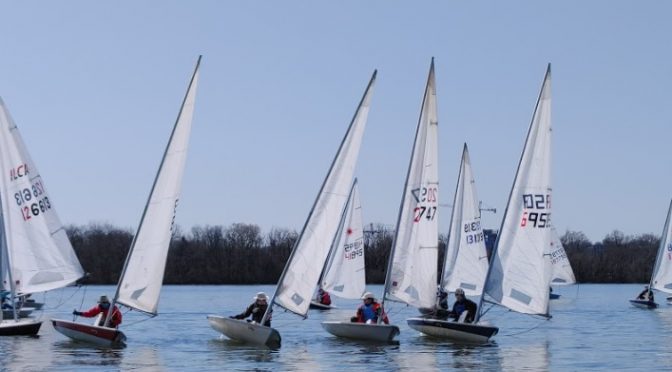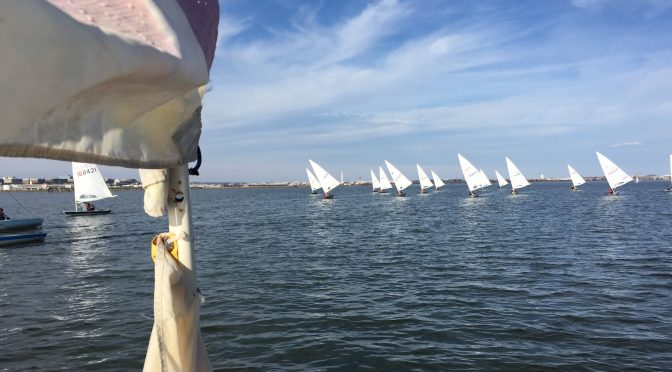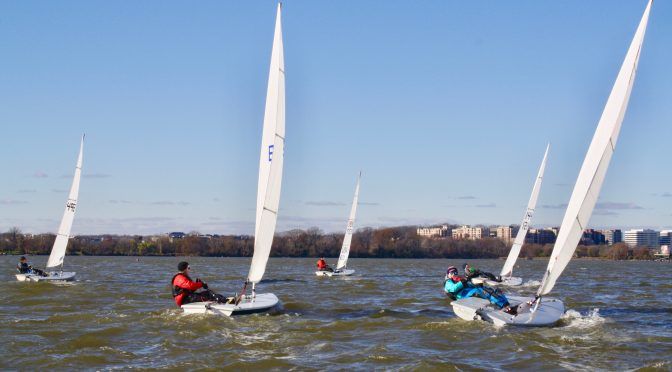It’s Groundhog Day with another 3rd place write-up from me. Surely no frostbites today – sunburns were more likely. It was like a high school dance in winter with few participants appropriately dressed for the temperature, the venue not quite fit for purpose, yet everyone seemingly having a good time. We’re used to shifting winds on the Potomac, but today took it to a new level. It reminded me of Rumsfeld when he confidently said the WMDs were, “east, west, south and north somewhat.” Dan and Mike energetically boated around trying to have the marks in the right direction only to find that between the warning sound and the start not only might it change which end of the starting line was favorable, but which was the more logical windward mark. Big thanks to Dan and Mike for adding another great sailing day, and to Farley for delivering the attached results.
Category Archives: 2020-2021 Frostbite
2020-2021 Laser Frostbite Series #15
Sunday was sunny, warmish, and probably the windiest frostbite day so far. John and Greg laid out an Olympic triangle course, which provided for planing when the gusts coincided with the reach legs. Greg and John heroically tried to adjust the course to the changing winds and were, on average, successful. Big thanks to John and Greg for RCing and to Farley for the attached results.
The starts were exciting – it was often possible to sail the length of the line in less than 20 seconds, so it quickly got crowded. I preferred shuttling between the pin and the boat and coming on port to find a good spot behind the RC boat about 35 seconds before the start. That way I avoided getting stuck in a crowd … it worked sometimes. Having, for once, the current largely in the same direction as the wind also made the typical strategy of lingering on the line viable.
On the upwind leg, gusts often came along with 30-40 degree wind shifts. That meant we had to be on our toes … or more literally ready to quickly adjust the sheet, rudder, and body position. The first victim I witnessed was Jim G., who had to tack as Farley came on starboard right at the time of a big gust and wind shift, which landed Jim with a taste of the Potomac.
Downwind was fun as there was just enough wind for a bit of waves to form. That allowed for practicing both following the waves and using body movement and sheeting to control the boat with minimal rudder. Supposedly s-turns on the downwind leg are more efficient, but I still haven’t figured them out. During stronger gusts, the jibing could also get exciting. At one point I was chasing Len for the first place he capsized right by the mark. I then managed to not only also capsize, but as I tried to climb around to the daggerboard I somehow tripped in a way that had me drop backward in the water hitting daggerboard on the way down before having my first taste of the Potomac. A far cry from the salty sea water I grew up with, but not as bad as feared. Glorious as my fail felt, had we had a weekly epic performance award, it would have probably gone to Tyler, who artfully lodged 8603 almost completely atop Celeste’s laser. Surely I missed many other exciting incidents – all in all, another beautiful Sunday on the Potomac.
Now, this is my 3rd 3rd place write-up, so I’d suggest we adjust to formula next season to include more authors. Not just because I’m lazy, but also for literary diversity and because I’m curious about others’ experiences and ideas.
Finally, happy International Women’s Day – it is truly a joy to have you dedicated, fearless, fun, and lovely women both on the water and on the dock – you represent the best of what IWD stands for!
2020-2021 Laser Frostbite Series #14
- Fuel. Keep the fuel tank above 1/2 full and ideally above 2/3 full. This prevents condensation, which prevents water in the fuel, which prevents the motor not working as what happened last week. There is no way to visually see water in the fuel; you know that watery fuel is likely the problem when the skiff won’t start. Thus, if it is your day and the fuel level is below 2/3 full (ish), go to the Shell station and fill up. There are gas tanks in the locker by the boat.
- Cover. Be sure the cover is on tight so that water does not pool and does not end up in the boat.
- Drain Plugs. There are three at the back of the boat. Make sure they are all in before launching.
- Motor up! There is a switch on the throttle that raises and lowers the engine; the engine MUST be up during trailering because it might hit something, especially the parking bumper in the trailer spot.
- Battery Switch. There is a switch in the big box at the back of the skiff that turns the battery on/off. This must be off at the end of the day.
- Head out of the boat (another reminder) – Sunday was one of those days when my position at any given point felt more tenuous than usual – if I was ahead, it could change easily, and if I was behind, especially at the first leeward rounding, there were often opportunities for catching up. Thus, it was a day that seemed to require a more than usual amount of paying attention to everything – other boats, how they were headed, the wind (which was patchy and not always easily visible on the water), and with the current, the location of the marks, especially the leeward mark. I didn’t do quite enough of this.
- Starts. The day started with a boat-favored line, which made things a bit crowded at the starboard end. To make things even more challenging, the current kept the committee boat facing upriver and perpendicular to the direction of the wind which meant that it was easier than usual to snag the anchor line due to both the orientation of the committee boat and the direction and magnitude of the current. One race I got snagged on the anchor line (note to self!). In the later races, I had decent luck starting further down the generous line and catching what seemed to be more wind/more favorable shifts on the left side of the course.
- Leeward Leg. Downwind legs tended to be very slow. Going high(ish) generally helped, but I had luck going a bit lower during some of the earlier races. Sometimes it was a regular downwind and sometimes it was more of a reach, even on the same leg! At one point I, like many others, had to approach close-hauled just to get to the leeward mark due to the wind mostly dying and having to battle the current. Fun times.
Additional comment. Thank you to those of you who were really good about yelling starboard and/or communicating about whether I could keep going or not. Let’s keep that communication up! Not just on windward legs, but noting overlaps (or not) at mark roundings too. It really helps.
2020-2021 Laser Frostbite Series #9
So we had a forecast on sunday of 5-10 from the NW shifting to SW sometime after noon. What with the lay of the land and the obnoxiousness of the front, we pretty much had both at the same time. It never filled in fully from the SW, but we had consistent oscillations to the west all day, and that was also where the pressure was better. So staying west generally paid off.
For most of the starts the line was square at some point in the sequence, but we got a lot of last minute westerly shifts which favored the port end. So I managed to get a couple really nice port tack starts. The current was around, but it never seemed to be a big deal this weekend.
At the start and on the first beat, when I had clear air I did well, and when I did not, it was awful. In the light conditions I found that disturbed air from boats to weather extend 6 or 8 boat lengths downwind. I think I paid more attention to clear air than even to the shifts. On the other hand, the shifts were big enough, and the course short enough, that tacking right away on the 10+ degree shifts made a big difference.
Finally, this was my best performance of the season, and I still placed third! I am still figuring out the leeward legs and the last mark rounding clearly has it in for me.
2020-2021 Laser Frostbite Series #7
Dear fellow frostbiters!
2020-2021 Laser Frostbite Series #6
Hi everyone,
2020-2021 Laser Frostbite Series #5
Dear fellow frost biters,
December 20 proved yet another beautiful race day run by our two grownups, Jim and Jacob. Short up-down courses and a short starting line provided abundant thrills and excitement in the first few races. After a couple of general recalls, J&J released the pressure on us with a longer start line and an Olympic course that calmed the mark roundings. A big thanks to J&J for an excellent set of varied races!
A few Annapolis exiles joined us again bringing new blood and adding to the vibrant racing. Thanks to whoever invited them and a warm welcome to our visitors and newcomers.
It seems tradition to reflect on sail trim. Many of you already know I’m back on the water after more than a couple of decades as a landlubber, and my last few pre-landlubber years were in a 27 ft keelboat (h-boat) with very different trimming. I think I’ve done well because of starts and other factors, so with weak confidence to advice on Laser trim, here’s what I was working on in the light wind.
Downwind: no cunningham, outhaul provided for a deep sail curve by the boom. I trimmed the kicking strap to where there is just enough control of the leech/twist, and I sometimes tightened it during puffs. I’m still trying to figure out how to sheet relative to the wind – a vane is on my list to Santa.
Upwind: clearly the combination of sheeting and the kicker is the key, no kicker is always too little, and with more wind, more is needed, but I haven’t figured out the balance. I play with it a lot. I usually find myself sheeting more loosely than others. I use very little cunningham if at all, and the outhaul is trimmed with the sail ~4-5 inches from the boom and only marginal variation.
Starts: I felt I did very well starting on the port end of the line as close to the mark as possible. After the tide turned, I thought it was better to be farther east, where I think the current is stronger, but I’m not really sure. Especially after we got a bit more space on the start line, rather than waiting in a promising spot, keeping moving around with some boat speed before the start seemed to allow me to find a good spot and cross the line with some momentum.
All in all another great day in the series, and I look forward to more. Until then, my best wishes for the holidays!
Thanks to Farley, the race results are attached
All in all another great day in the series, and I look forward to more. Until then, best wishes for the holidays!
2020-2021 Laser Frostbite Series #4
I was afraid going into the last race yesterday that this might be my fate.
Well actually I was pretty pleased.
Arriving at the dock at 11, it looked the westerly breeze had nearly died. As we got out to the race course, the northerly shift arrived and started filling in. In the first 2 1/2 races, the right side was strongly favored. In the first three races I got out to the right early, and was at or near the front at the first mark each race. The wind started shifting left in the middle of the third race and several boats who took the chance did well.
The wind shifted fairly strongly to the left at the end of the race, leaving the starting pin strongly favored. So I worked hard to get port tack starts for the last three races. In races 4 and 6 I missed the front hole, and had to cross some sterns. I was actually over early in race 4, and went around the pin, but was able to find a nice lane and clear air. In race 5, I was right on the line, and only “let” Tom pass me at the last leward mark. I still haven’t figured out how to do everything one needs to do down there.
Best thing on the day for me was being able to see where the wind was and get there. Worst thing is still that leward mark rounding.
Thanks to Farley for doing RC solo.
John Van Voorhis
2020-2021 Laser Frostbite Series #3
Hello Sailors,
2020-2021 Laser Frostbit Series #3
Photo Credit to Kaitlyn Lucey
2020-2021 Laser Frostbite Series #2
Thanks to Jim Klein for providing a seamless solo RC experience.



